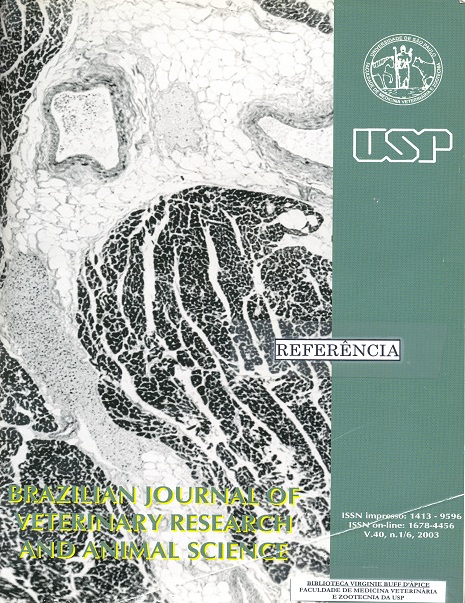Evaluation of synchronization of ovulation for fixed timed insemination in buffalo (Bubalus bubalis)
DOI:
https://doi.org/10.1590/S1413-95962003000600007Keywords:
Synchronization of ovulation, GnRH, Buffalo, OvsynchAbstract
The objective of this study was to evaluate the efficiency of synchronization ovulation protocol (GnRH/PGF2alpha/GnRH) for fixed timed insemination in buffalo. In Experiment 1, thirty-three female buffaloes with 60 days postpartum, were divided in two groups for evaluation of the follicular dynamics (Group 1, n = 16, 10mg of GnRH/15mg of PGF2alpha/10mg of GnRH; Group 2, n = 17, 20mg of GnRH/15mg of PGF2alpha/10mg of GnRH). Ultrasonography exams were performed every 12 hours to verify the ovarian response to the first GnRH injection. Another evaluations were performed on PGF2a injection and second GnRH injection. After last hormonal injection, ultrasonography exams were performed every 6 hours to verify the moment of the ovulation. Blood samples were collected on Days 0, 7 and 9 to evaluate the progesterone concentrations at the moment of the hormonal injections. In Experiment 2, the efficiency of the synchronization of ovulation was verified for fixed timed insemination (16 hours after second GnRH injection, n=1053), during the favorable and unfavorable reproductive season, in the years of 1998 and 1999. Animals received 20mg of GnRH/15mg of PGF2alpha/10mg of GnRH. Besides, also recorded and evaluated aspects like body condition score, parity, postpartum period, year and the reproductive season (favorable or unfavorable season), on the conception rate. In Experiment 1, it was verified that 33.0 ± 8.3h after the first GnRH injection, 60.60% of the animals ovulated (Group 1 = 70.5 vs. Group 2 = 50.00%; P>;0.05). The dose of GnRH (10mg vs. 20mg) and the progesterone concentration did not interfere in ovulation in the beginning of the treatment (P>;0.05). Animals that ovulated (n = 20) after the first GnRH injection presented larger follicular diameter (P ;0.05). In Experiment 2, it was observed conception rate of 45.40% (n = 1053). Animals synchronized during the favorable reproductive season presented better conception rate than the unfavorable season (48.80% vs. 6.90%; P ;0.05). In summary, the Experiments indicated that the use of synchronization of the ovulation for fixed timed insemination, during the favorable reproductive season, presents satisfactory results in buffalo and could still be better when used multiparous buffaloes with good body conditon score in the beginning of the treatment.Downloads
Download data is not yet available.
Downloads
Published
2003-01-01
Issue
Section
UNDEFINIED
License
The journal content is authorized under the Creative Commons BY-NC-SA license (summary of the license: https://
How to Cite
1.
Baruselli PS, Madureira EH, Barnabe VH, Barnabe RC, Berber RC de A. Evaluation of synchronization of ovulation for fixed timed insemination in buffalo (Bubalus bubalis). Braz. J. Vet. Res. Anim. Sci. [Internet]. 2003 Jan. 1 [cited 2024 Jul. 26];40(6):431-42. Available from: https://www.revistas.usp.br/bjvras/article/view/11296





